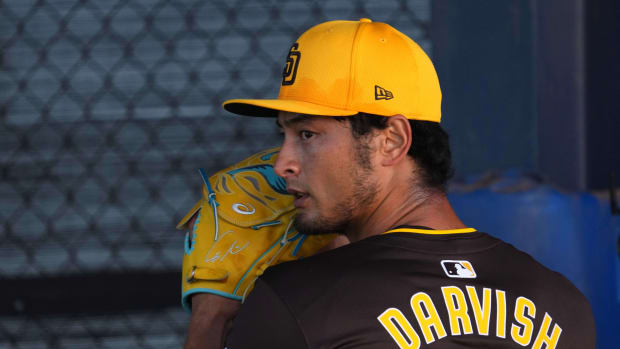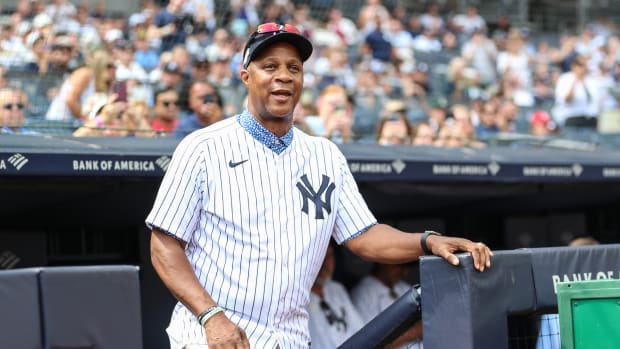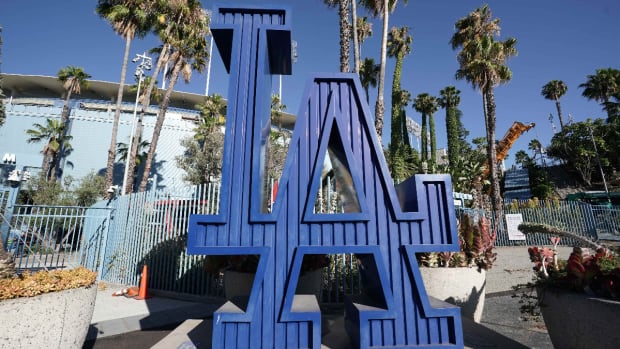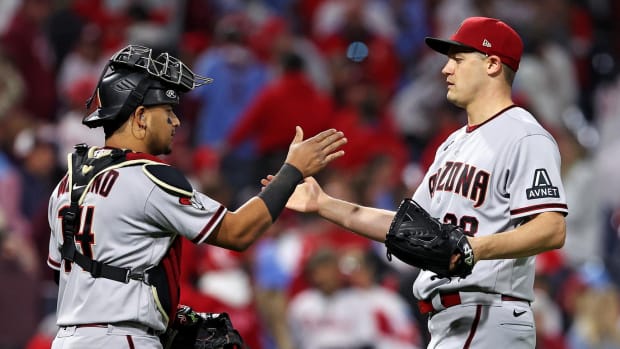Pine Tar Game: An oral history of the most controversial home run ever hit
Your teams. Your favorite writers. Wherever you want them. Personalize SI with our new App. Install on iOS or Android.
NOTE: This story originally ran on SI.com on July 24, 2013, the 30th anniversary of the Pine Tar Game.
"The bat handle, for not more than 18 inches from the end, may be covered or treated with any material (including pine tar) to improve the grip. Any such material, including pine tar, which extends past the 18-inch limitation, in the umpire's judgment, shall cause the bat to be removed from the game. No such material shall improve the reaction or distance factor of the bat." — Rule 1.10 (b), Official Rules of Baseball, 1983
On July 24, 1983, an otherwise forgettable game between the Kansas City Royals and New York Yankees at Yankee Stadium earned a permanent place in baseball lore because of what transpired in the top of the ninth inning. The Royals trailed the Yankees 4-3 with two outs when star third baseman George Brett hit a home run to rightfield off Yankees closer Goose Gossage.
That in itself was not particularly noteworthy, but what followed certainly was. Even before Brett touched home plate, Yankees manager Billy Martin was out of the dugout ordering the umpires to inspect Brett's bat for excessive pine tar. The umpires determined that the bat did in fact exceed the allowable 18-inch limit, and concluded that Brett had used an illegal bat. He was ejected and his hit nullified, ending the game. Temporarily, it turned out.
Brett's reaction—sprinting out of the dugout and going right for home plate umpire Tim McClelland, who was in his first full season—instantly became one of the most bizarre and unforgettable scenes in baseball history. The Royals filed a protest of the call with the American League president, who upheld their protest and ordered the game to be resumed on Aug. 18. This time, Kansas City held on for a 5-4 win in what was already becoming known as the Pine Tar Game.
In honor of the 30th anniversary of the game, SI.com contacted those involved to hear their memories of the day and the events that followed. Interviews by SI.com contributor Mel Antonen. Additional reporting by Stephanie Apstein. Text by Ted Keith.
Both teams had already experienced less memorable pine tar moments long before their fateful encounter on that sweltering Sunday in the Bronx. On July 19, 1975, Twins manager Frank Quilici—a disciple of Martin's—used the little-known rule to take away an RBI single by New York's Thurman Munson in the top of the first inning.
Minnesota went on to a 2-1 win that was almost immediately forgotten, except perhaps by Quilici and a very alert Yankees third baseman. And on Sept. 7 of that year, the Royals' John Mayberry had his bat inspected for excessive pine tar, though the home runs he hit that day against the Angels were not overturned.
Frank Quilici (Twins manager, 1972 to '75): I'd always heard about the rule and thought it was screwy. We were in tough shape that season. Harmon (Killebrew) was gone. Tony Oliva was on one leg. Our shortstop, Danny Thompson, was battling leukemia. Sometimes, our owner (Calvin Griffith) wouldn't bring any one up from the minors when we had injuries and we'd play with a 22-man roster.
I used to stay up at night and read the rule book, looking for any advantage that I could find to help our team win a game. I read about the pine-tar rule. I remembered it and thought I would use it when the time came. On that day we used it against Munson, I remember going up to the plate umpire and saying, "This is bush league, but he has too much pine tar on his bat." He called him out. Munson was livid. He wanted to kill me. He wanted to fight, much like Brett years later. I tried to stay away from him because Munson had quite a temper.
It was a play Billy Martin would be proud of. He liked to read about generals and world leaders and he managed a game like a general. Things had to be done his way or else. He expected you to follow along.
Martin already had a well-earned reputation for rarely missing an opportunity to shake things up, be it on or off the field, by the time he became Yankees manager midway through the 1975 season. Martin guided the Yankees to the pennant the next year and the World Series title in 1977. Both times, New York took out the Royals in best-of-five ALCS showdowns that were decided in the final inning of the final game. They also dispatched the Royals in four games in the 1978 ALCS, though Martin had been fired at midseason. Kansas City finally broke through against the Yankees in the 1980 ALCS with a three-game sweep that was punctuated by Brett's go-ahead home run into the upper deck off Goose Gossage in the final game in the Bronx.
The Royals lost the World Series that year to the Phillies. Brett, who had captured the nation's attention by hitting .390 that season and would win the AL MVP award, made headlines for less glorious reasons when he had to leave Game 2 because of hemorrhoid pain.
By 1983, Brett was in the eighth year of what would be 13 consecutive All-Star seasons. Martin was back for the third of what would be five stints as Yankees manager and he had lost neither his combativeness nor his competitiveness, and the rivalry between the two clubs still simmered.
Lou Piniella (Yankees outfielder, 1974 to '84): As a team, we didn't really like Kansas City. We had played them in the '76, '77 and'78 postseason and beaten them every time.
There was no love lost between the teams. We didn't like each other. They were our big rivals and Brett was as good a hitter as there was.
George Brett (Royals third baseman, 1973 to '93): I hated everyone on the Yankees, I really did. I hated 'em all, back in that era.
Goose Gossage (Yankees pitcher, 1978 to '83): We had quite a rivalry going with the Royals. We didn't like George Brett and they didn't like us. I hated George Brett. He was such a good hitter, and it was hard to get him out. He hit really well against us in the playoffs, and so that added to it.
Everybody thought Billy Martin came up with the idea, but it was actually Graig Nettles who told Billy about the rule.
Graig Nettles (Yankees third baseman, 1973 to '83): We were playing in Kansas City a couple of weeks before they came to New York, and we had noticed the excessive pine tar on Brett's bat, so I told Billy about it, and he said, "That's a good deal. If he gets a big hit against us, I'll bring it up."
Brett: I applied (pine tar) before every at-bat. I was one of the few players then and probably would be one of the few players now that never wore batting gloves. On July 24 it's pretty hot in New York and a little muggy, so your hands sweat, so there was a lot of rosin, there was a lot of pine tar on my bat, and I used that bat for probably three or four weeks. As a result of using a bat for that length of time and putting pine tar on four, five times a day, it's going to get pretty ugly, and the bat was pretty ugly, but it was still working.
Piniella: Brett's home run was gigantic. It was gone as soon as it left the bat.
Joe Brinkman (crew chief and second base umpire): We expected that protest from the Yankees was coming, so when Brett hit the home run, I knew what Billy Martin was talking to Tim (McClelland) about. He waved me in and said, "Here's what we've got." And, I said, "Well, he's correct."
As we were huddled, (umpire) Nick Bremigan came up with the idea of measuring the bat at home plate. We laid it there so that we could show everyone in the world that the pine tar was too high on the bat. We wanted to show it instead of just saying it.
Nettles: I remember after the home run, thinking, "We're going to get this one back because of a technicality."
• Worst baseball team ever? Try the Philadelphia Pathetics
Brett: Back then there were a lot of guys using corked bats. I know there was a few guys I played with that used them, and that's what I was thinking that they were gonna call me out for, because I had never heard any rule about excessive pine tar on a bat.
So when I was sitting in the dugout and somebody said, "Did you cork your bat?" I'm going, "No, I don't need to cork my bat and I don't know how to cork a bat." And then Frank White, who's sitting pretty close to me says, "You know, when they measured your bat, when they dropped the bat on home plate to measure it, they might call you out for using too much pine tar on your bat." I go, "What do you mean?" And Frank might have said something about—I think it happened to John Mayberry—and I go, "Well, if they call me out for using too much pine tar, I'll go out there and I'll kill one of those SOBs."
I swear to God, as soon as I said that, Tim McClelland starts looking for me, and he finds me, and he calls me out.
Brinkman: I remember saying, "Tim, do you want me to call him out?" He said, "I got the plate, I'll do it." He probably wishes that he had let me do it.
John Wathan (Royals first baseman, 1976 to '85): In the dugout, George asked what they were doing, what they were talking about. I told him, "I think they are going to call you out." George said,"'What do you mean?" He was so angry. I was going to try and stop him, but he was out of the dugout so damn quick, I didn't have time to do anything.
Piniella: He came charging out of that dugout with a full head of steam, no helmet on, hair flying. It was like he was running from a bull in one of those bull runs in Spain.
Brinkman: George wanted to kill Tim. He came running out, and I got a pretty good (choke) hold on him and kept him from getting to Tim. There was no time for thinking. It was just a reaction on my part.''
Gossage: I have never seen anyone as mad as George Brett on that day.
Tim McClelland (home plate umpire): We had to decide on the letter of the rule. We can't decide between good and bad rules. A rule is a rule. I knew we were interpreting the rules the right way.
Gaylord Perry, being the man of foreign substance that he is, got the bat and took it out of my hands. He threw it to Rocky Colavito. I went to grab it from Rocky, and he held it up over his head like he was going to hit me with it.
Gaylord Perry (Royals pitcher, 1983): It's something that had to be done. We had to take control of the evidence.
McClelland: We had to go get the bat. The players were trying to take it into the clubhouse. A security officer got it for us, and Joe locked it in the umpires' dressing room.
Brett: [Royals manager] Dick Howser came in and had his fit in the locker room, started screaming at me for using an illegal bat. I said, "I don't even know what you're talking about! I didn't know it was illegal!" By the time we got on the bus, it was pretty funny, and that's when I started hearing about the bat boy or somebody was running the bat up through the dugout tunnel and the security guys are chasing him, on their walkie-talkies, saying, "Okay, the bat is now in the dugout, it's running up the runway, somebody lock the front door of the locker room, don't let them in the locker room!" And sure enough, they confiscated the bat right there.
Don Mattingly (Yankees first baseman, 1982 to '95): I remember afterward, Billy thinking that he out-smarted everybody. He got his way. He was always scheming and this time, it had worked.
For the moment at least. The Yankees had a 5-4 win but Kansas City quickly filed a protest with Lee MacPhail, the American League president. The Royals headed to LaGuardia Airport for a flight to Detroit, where they crossed paths again with McClelland.
McClelland: Brett was using a pay phone. I said, "George you aren't still ticked at me?" He said, "Hell yes, I am. That call was B.S." So I thought to myself, Never mind, and I kept walking. But, if looks could kill, I'd be a dead man.''
Brett: Right after the game, I didn't think much of it, to be honest with you. I remember after the game getting to my hotel room, calling up one of my brothers to tell him what happened, and he said, "I know, I was watching another game on TV and they broke in and showed what happened." I thought it was just going to be over with. I didn't think it was that big a deal.
John Schuerholz (Royals general manager, 1981 to '90): We protested the game, and then we were waiting for word from the league. We were anticipating a ruling in our favor.
• A Hall of Famer and a Chicken: An oral history of The Baseball Bunch
On July 28, they got one. MacPhail overturned the umpires, saying that the umps' decision, "while technically defensible, is not in accord with the attempt or spirit of the rules" and ordered the game to be resumed. Yankees owner George Steinbrenner was not pleased.
Andy MacPhail (Lee's son and a longtime executive with several MLB teams): George Steinbrenner said that if the Yankees lose the AL East by a game, that my dad should consider looking for a house in Kansas City. My father didn't sweat that stuff. He was principled and confident in his decision. He knew it was the proper thing to do.
My father was careful not to blame the umpires in any way, shape or form because it was a poorly-written rule. He didn't believe pine tar of more than 18 inches helped propel the ball. It was a ruling not often made, and it came at the expense of the team in the city where he was living.
Piniella: We felt like we had done the right thing. A rule was a rule. We felt pretty assured that it would stand up, but I guess we always knew there was a chance that they could change it.
Nettles: It was a stupid rule. Lee MacPhail got the decision right. It was a rule that didn't make sense.
Tom Cosentino (Yankees PR intern): I was given the task by my boss [Ken Nigro] to come up with bad trades that Lee MacPhail had made as Yankees general manager. Apparently, this was something Mr. Steinbrenner had requested and Ken wanted to have in reserve if pressed by the Boss. As a Yankees fan, it was easy to come up with some of the bad deals, such as Stan Bahnsen for Rich McKinney, Roger Maris for Charlie Smith and Clete Boyer for Bill Robinson. Just to be fair, I also came up with positive trades, such a getting Graig Nettles from Cleveland.
I don't think anything was ever done with the list of bad deals. Nigro would often gather information Steinbrenner asked for in a fit of rage and then store it away, knowing he would probably forget about it. But Ken wanted to be prepared.
MacPhail ordered the game to be resumed on Aug. 18 from the point of the home run, with Kansas City now leading 5-4 in the top of the ninth with two outs and the bases empty. The Royals, who were already in the midst of a stretch in which they played seven doubleheaders from July 31 through Aug. 25, were on a flight to Baltimore when they found out they had to go to New York, cancelling what was supposed to be a much-needed off day.
Larry Ameche (TWA sales rep who traveled with the team): We were going to play the Orioles and we were about 90 minutes into the flight. I had to go ask the pilot if we could change our destination to New York. He said, "You're kidding me. Let me make a few phone calls." He did and pretty soon, I felt the plane make a sharp left.
When the plane landed at Newark Airport, the team went to Yankee Stadium while Ameche and Brett went to a nearby restaurant for lunch.
Brett: I'm glad I didn't come back for that. That would've been a tough place to come to. Larry knew a good little restaurant out in New Jersey by the airport. We sat at the bar and had some Italian food and watched the four outs on TV.
Brett and Ameche missed some final theatrics from Martin. He first tried to appeal to make sure Brett had touched all the bases, only to be rebuffed by an affidavit from Brinkman's umpiring crew that Brett had in fact done so. Martin then offered a milder form of protest by sending the lefthanded Mattingly out to play second base and putting pitcher Ron Guidry in centerfield when play resumed. That was the extent of the drama that day at the Stadium. It took just 12 minutes to complete the game, with all four batters being retired. After 25 days, the Royals finally had a 5-4 win.
Epilogue
The Yankees, who were just two games out in the AL East on July 24 and still only 3 ½ back on Aug. 18, couldn't keep pace with the surging Baltimore Orioles and finished 91-71, in third place. Gossage and Nettles both left after the season and helped the Padres reach the World Series in 1984. Martin, too, was gone, having been fired after the season, though he would return in 1985 and 1988 only to be fired both times.
The Royals, meanwhile, were within a game of first in the AL West on July 25 but struggled mightily thereafter and wound up 79-83, 20 games behind the division champion White Sox. Brett finished the season with a .310 batting average and led the majors in slugging percentage and OPS. Two years later, he helped the Royals win their first and only World Series title. Brett retired in 1993 after 21 seasons, all in Kansas City, and 3,154 hits. He was elected to the Hall of Fame in 1999; Gossage joined him in Cooperstown in 2008. This past May, Brett was hired as the Royals hitting coach.
Brinkman: George is a super guy. He tells me, after all these years, that he can't play golf because his neck hurts. "You wrenched it," he tells me. George can't play golf anyway.
• Subscribe to get the best of Sports Illustrated delivered right to your inbox
Brett: The week after the game, Joe Brinkman sent me a telegram when Lee MacPhail overruled the umpires' decision, and I still have the telegram at home: "Congratulations, a big day for you. Looking forward to seeing you again soon." That was classy.
McClelland: We kid about it all the time. In my 30 years of umpiring, George Brett has been the best player toward umpires. He enjoys the game, joking around, having fun. Whenever my crew was umpiring the games he played, he'd poke his head in our locker room and say, "Good luck, I'll be pulling for you." Then he'd shut the door.
The No. 1 question I get is, "What was he saying?" I always say, "I have no idea." I don't have much recollection of that. It all happened so fast. But I tell people at roasts that I'm 6' 6" and 250 pounds, wearing protective gear and holding a bat. How stupid was he to come out after me? Now George uses that line in his talks. I should collect royalties.
Brett: I think people realize that in 1980 I came five hits from hitting .400 and I was the closest guy since Ted Williams did it in 1941. People know that and people know of the All-Star games and 3,000 hits. This is just a little asterisk to go along with it, and I'm fine with that.
But the (Royals) players know. Every year in spring training, I talk to all the minor leaguers. It is just me and them, no coaches, no nothing, and I talk for about 40 minutes. Then we do a question-and-answer, and there's always some new kid in the organization, some 18-year-old kid out of high school, "Hey, tell me about the Pine Tar Game." And it's hard for me to really imagine and remember that these kids weren't even born yet.
Prior to the Pine Tar Game, July 24, 1983, and after the World Series in 1980, every city I went to I was the hemorrhoid guy. I heard every hemorrhoid joke in the world. My best response is, 'My troubles are all behind me.' But from October of 1980 to July 24, 1983, that's what I heard. And from July 24 to 2013, now I'm the pine-tar guy, so it's really the greatest thing that ever happened to me. Thank you, Billy Martin, thank you, Graig Nettles. I went from having an embarrassing thing that people remembered you for to something positive.





































